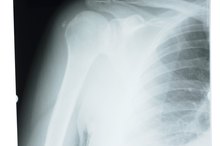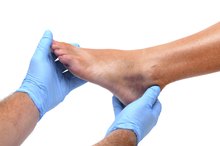What Are the Treatments for a Torn Tendon?
Because the tendons of the human body connect active muscle tissue to passive bone, they act as shock absorbers that sometimes tear from too much wear. Either a pulled muscle or a tendon strain itself can cause tendon fibers to tear. Among the areas vulnerable to tendon problems are the rotator cuff of the shoulder and the Achilles tendon of the foot. The treatments for a torn tendon depend on individual pain thresholds and tissue repair rates, as well as the extent of the damage.
Rest and Protection
A torn tendon will hurt when it moves or when weight or force is placed on it. The Mayo Clinic reports a variety of immobilization treatments that reduce tendon strain and offer pain relief. Resting to the degree that creates the least pain should come first, whether it is full bed rest, a suspension of athletic workouts or restriction of daily activities.
Inflammation around a tissue tear may increase when blood flow increases during movement. Supporting the pulled muscle and tendon area with a compression bandage, sling, splint, crutches, cane or another aid will cut down on the swelling and make moving and getting around easier.
- A torn tendon will hurt when it moves or when weight or force is placed on it.
Pain Relief
Can I Lift Weights With a Glenoid Labrum Tear?
Learn More
As soon as symptoms of a tendon strain develop, first aid pain relief should accompany rest treatment. Reusable chilled gel packs make convenient cold compresses for pulled muscles and tendons in the foot, leg, back, rib cage, shoulders, arms and neck.
The University of Buffalo Sports Medicine group suggests at least three ice treatments of up to 30 minutes per day while swelling is present. This can be used to supplement drug therapy for a torn tendon because short-term medications such as ibuprofen, aspirin and naproxen may need to be curtailed before the pain fully disappears.
- As soon as symptoms of a tendon strain develop, first aid pain relief should accompany rest treatment.
- This can be used to supplement drug therapy for a torn tendon because short-term medications such as ibuprofen, aspirin and naproxen may need to be curtailed before the pain fully disappears.
Physical Therapy
Treatments to mend a torn tendon include restoring the tissue’s strength, flexibility and endurance. Physical therapy should start with gentle stretches of the pulled muscle and tendon area, followed by a gradual re-establishment of the patient’s usual exercise routine. The Mayo Clinic notes that a doctor or physical therapist can set safety boundaries and fitness goals for individual patients.
Surgical Treatment
Degrees of Ankle Sprain
Learn More
Tendon strains that result in complete separation of muscle and joint or bone may need surgical operations to repair the tissue. The University of Buffalo Sports Medicine group reports that arthroscopic surgery can address some tissue displacement or ruptures. According to the University of Maryland Medical Center, however, extensive damage that involves bone spurs, joint fractures or other extenuating circumstances may require open surgery.
Related Articles
References
- MayoClinic.com: Achilles Tendinitis
- Shi F, Wu S, Cai W, Zhao Y. Multiple comparisons of the efficacy and safety for six treatments in Acute Achilles Tendon Rupture patients: A systematic review and network meta-analysis [published online ahead of print, 2020 Jul 18]. Foot Ankle Surg. 2020;S1268-7731(20)30153-3. doi:10.1016/j.fas.2020.07.004
- Apinun J, Jenvorapoj S, Arirachakaran A, Kongtharvonskul J. Clinical outcomes of chronic Achilles tendon rupture treated with flexor hallucis longus grafting and flexor hallucis longus grafting plus additional augmentation: A meta-analysis [published online ahead of print, 2019 Sep 28]. Foot Ankle Surg. 2019;S1268-7731(19)30154-7. doi:10.1016/j.fas.2019.09.006
- Park YH, Jeong SM, Choi GW, Kim HJ. How early must an acute Achilles tendon rupture be repaired? Injury. 2017 Mar;48(3):776-780. doi: 10.1016/j.injury.2017.01.020. Epub 2017 Jan 9. PMID: 28088376.
- Yongliang Y, Honglei J, Wupeng Z, et al. Intraoperative ultrasonography assistance for minimally invasive repair of the acute Achilles tendon rupture. J Orthop Surg Res. 2020;15(1):258. Published 2020 Jul 11. doi:10.1186/s13018-020-01776-6
- Lee KT, Park YU, Jegal H, Roh YT, Kim JS, Yoon JS. Femoral and sciatic nerve block for hindfoot and ankle surgery. J Orthop Sci. 2014;19(4):546-551. doi:10.1007/s00776-014-0576-5
- Baxter JR, Corrigan P, Hullfish TJ, O'Rourke P, Silbernagel KG. Exercise Progression to Incrementally Load the Achilles Tendon [published online ahead of print, 2020 Jul 9]. Med Sci Sports Exerc. July 9, 2020. doi:10.1249/MSS.0000000000002459
Writer Bio
Nancy Clarke began writing in 1988 after achieving her Bachelor of Arts in English and has edited books on medicine, diet, senior care and other health topics. Her related affiliations include work for the American Medical Association and Oregon Health Plan.








